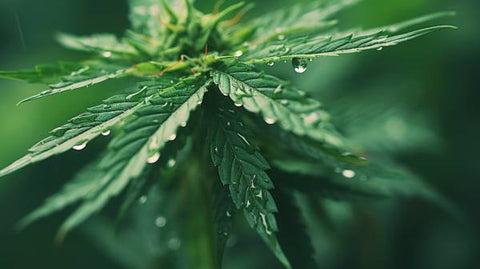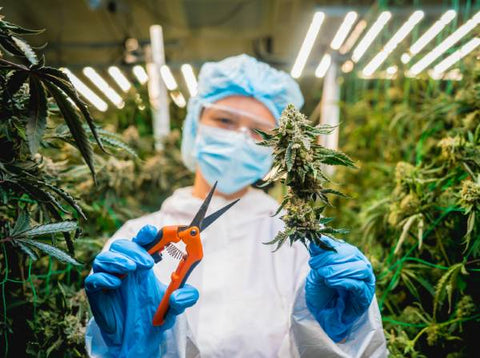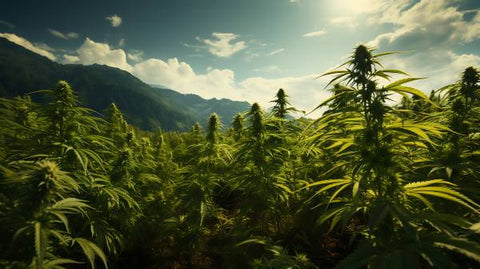Mejor precio del mercado

5 tips for growing marijuana outdoors
Outdoor marijuana cultivation is an activity that has gained popularity in recent years due to its accessibility and the possibility of obtaining high-quality crops. Growing marijuana outdoors is a rewarding adventure that combines gardening with a passion for this unique plant. Unlike growing indoors, growing marijuana outdoors allows you to take advantage of natural resources, such as sunlight and rain, which can result in a more organic and sustainable experience. However, to be successful in growing marijuana outdoors, it is crucial to understand and apply the key aspects that allow for healthy and productive plant growth.
We will explore the secrets and tricks to successfully plant marijuana outdoors. We will reveal five essential tips that will help you become an expert grower, maximizing your results and enjoying high-quality harvests. From choosing the right location to the harvesting and drying process, we will guide you through every essential step in the outdoor marijuana growing process.

Tip 1: Selecting the Right Location for Outdoor Growing
Choosing the right location is a crucial step in growing marijuana outdoors, as it can mean the difference between a bountiful, healthy harvest and a disappointing one. Here we offer you a detailed explanation about the importance of this aspect and the factors you should consider, as well as some tips to prepare the soil or growing medium effectively.
Importance of Venue Choice
Choosing the right place to grow marijuana outdoors is essential, since the plant needs optimal conditions to grow healthily and produce high-quality buds. Some of the reasons why this is crucial include:
- Sun Exposure : Marijuana is a plant that requires a significant amount of direct sunlight for proper growth and flowering. Choosing a location with good sun exposure ensures that the plants receive the necessary amount of light throughout the day.
- Privacy and Security : Privacy and security are important factors to consider, especially if you live in an area where marijuana cultivation may be legal but regulated. A discreet and safe location will help protect your plants from prying eyes and potential legal problems.
Factors to Consider
When evaluating a location for growing marijuana outdoors, you should pay attention to the following factors:
- Sunlight : Find a location that receives at least 6 hours of direct sunlight per day. Ideally, more hours of sun will improve the performance of your plants.
- Privacy : Choose a place away from curious eyes and neighbors who could cause problems. A fence or bushes can help maintain privacy.
- Security : Make sure the location is secure and that your plants are protected from potential thieves or damage.
- Soil Drainage : Evaluate soil drainage. Stagnant water can be harmful to plant roots.
Tips for Preparing the Soil or Growing Medium
Once you have selected the right location, it is essential to prepare the soil or growing medium to ensure healthy growth of your plants. Here are some tips:
- Soil Test : Perform a pH and nutrient test on the soil to understand its conditions. Adjust the pH if necessary and enrich the soil with appropriate nutrients.
- Soil Improvement : Add organic matter such as compost to improve soil structure and water retention.
- Irrigation : Make sure the location has access to water for irrigation. Consider installing a drip irrigation system if necessary.

Tip 2: Choosing the Appropriate Marijuana Strains for Outdoor Growing
Choosing the right marijuana strain is a fundamental step in successful outdoor cultivation. There are three main types of marijuana varieties: sativa, indica and hybrid, each with unique characteristics that influence their growth, effects and adaptability to different climates. Here I provide you with a detailed description of these varieties and tips on how to select the most suitable one based on the climate and your preferences as a grower.
1. Sativa
- Characteristics : Sativa varieties are usually tall, slender, and have thin leaf blades. They have a longer flowering period compared to indicas.
- Effects : Sativas tend to provide a more energizing and creative cerebral effect. They are ideal for daytime activities.
- Climate Adaptability : Sativas are suitable for warmer, sunnier climates, as their longer flowering period makes them more prone to problems related to cold, wet weather.
2. Indica
- Characteristics : Indica varieties are shorter and more robust, with wide, compact leaves. They have a shorter flowering period.
- Effects : Indicas usually produce a relaxing and sedative effect, ideal for nighttime use or for medicinal purposes.
- Adaptability to Climate : Indicas are more resistant to cold and humidity, so they are suitable for less hot and more variable climates.
3. Hybrids
- Characteristics : Hybrid varieties are crosses between sativa and indica, which allows them to combine characteristics of both. They can vary in height, shape and flowering period.
- Effects : The effects of hybrid varieties can vary depending on the proportion of sativa and indica genes in their composition.
- Climate Adaptability : Climate adaptability will depend on the specific genetics of the hybrid variety, so it is important to research and select hybrids suitable for your local climate.
Recommendations for Selection
- Research the varieties available and consult with other local growers to learn their experience with different strains in your area.
- Consider the climate of your region. If you live somewhere with cold winters, indicas or hybrids with indica genes may be a better choice. For warm, sunny climates, sativas may be an option.
- Think about your personal preferences. Are you looking for an energizing or relaxing effect? Do you have space limitations in your growing area?
- Make sure you purchase quality seeds from a trusted seed bank to ensure the varieties are genuine and well suited to your needs.

Tip 3: Basic Plant Care when Growing Marijuana Outdoors
Proper care of your outdoor marijuana plants is essential to ensure healthy growth and a bountiful harvest. Here you will find details on the key aspects of watering, nutrition and pruning your plants, as well as tips to maintain their health and maximize yield.
Irrigation
Watering is one of the most critical aspects of caring for outdoor marijuana plants. Here are some important tips:
- Irrigation Control : Avoid excessive or insufficient irrigation. You should keep the substrate moist but not soaked. Marijuana prefers a regular watering cycle rather than floods and droughts.
- Deep Watering : Water deeply to encourage a strong root system. Make sure the water reaches the deepest roots of the plant.
- Avoid Stagnant Water : Make sure pots have good drainage to avoid stagnant water, which can cause root and fungal problems.
Fertilizers
Proper nutrition is essential for plant development. Here are some guidelines to ensure your plants receive the necessary nutrients:
- Fertilizers : Use specific fertilizers for marijuana and follow the manufacturer's instructions. Start with low doses and gradually increase according to the plants' needs.
- Essential Nutrients : Marijuana plants need nitrogen, phosphorus and potassium (NPK) in different proportions at each stage of their life cycle. Make sure you provide the right nutrients at the right time.
- Micronutrients : In addition to macronutrients, plants also require micronutrients such as iron, zinc, and manganese. A micronutrient supplement may be beneficial if deficiencies are detected.
Marijuana Pruning
Proper pruning can improve plant health and increase bud production. Here are some pruning tips:
- Pruning Lower Branches : Remove lower branches that do not receive enough light to encourage air flow and reduce the risk of mold and mildew.
- Pruning Damaged Leaves : Remove damaged or diseased leaves to prevent the spread of disease and allow the plant to focus its energy on the growth and development of the buds.
- Topping and FIMing : These advanced pruning techniques can increase the number of buds and encourage an even distribution of the plant's energy.
Additional Tips
- Watch your plants closely for signs of stress, pests or disease.
- Keep track of your watering and fertilization practices to adjust them as necessary.
- Maintain a clean, weed-free environment around your plants to reduce competition for nutrients and space.

Tip 4: Pest and Disease Control when growing outdoors in soil
Controlling pests and diseases in marijuana is a critical aspect to guarantee the success of your outdoor marijuana cultivation. Identifying and addressing these threats effectively is essential to maintaining healthy plants and a bountiful harvest. Below are some of the most common pests and diseases when growing marijuana outdoors, as well as organic and natural strategies to prevent and treat these problems.
Common Pests
- Mites : Mites are small arachnids that can damage plant leaves by sucking sap. You can prevent them by introducing natural predators like ladybugs or by applying organic insecticidal soap.
- Caterpillars : Caterpillars can cause serious damage by chewing on plant leaves. Regularly inspect your plants and manually remove any caterpillars you find. You can also use pheromone traps.
- Spider Spiders : These small arachnids can cause damage to leaves by spinning webs and sucking sap. Increase the humidity in your growing area to prevent their proliferation and consider the introduction of predators such as predatory mites.
Common diseases
- Gray Mold (Botrytis) : Gray mold can affect the buds and leaves of plants. Reduce humidity in the growing area and make sure there is good air circulation to prevent this. You can also apply garlic extract as a natural fungicide.
- Powdery mildew : Powdery mildew is a fungus that forms a white coating on the leaves and buds. Use a solution of baking soda and water to spray the plants as a preventive measure and insulation.
- Powdery Mildew : This fungus causes white spots on leaves. Apply neem oil or milk spray to combat it effectively.
Organic and Natural Strategies for Control
- Beneficial Predators : Introduce beneficial insects such as ladybugs, predatory mites or parasitic wasps to keep pests under control.
- Neem Oil : Neem oil is an organic pesticide that can help control many pests and diseases.
- Insecticidal Soap : Organic insecticidal soaps are effective in controlling mites and other sucking pests.
- Pheromone Traps : Pheromone traps are useful for controlling caterpillars and other flying insects.
Prevention
Prevention is key to avoiding pests and diseases in the first place:
- Crop Rotation : Avoid planting marijuana in the same location year after year to reduce the buildup of pathogens in the soil.
- Maintaining Healthy Plants : Healthy plants are less prone to disease. Be sure to provide adequate watering and nutrition.
- Hygiene : Wash your hands and tools before touching plants to prevent the spread of disease.

Tip 5: Harvesting and Drying when Growing Marijuana Outdoors
Harvesting and the drying and curing process are critical stages to obtain high-quality marijuana. Below, I will provide you with a detailed explanation of when and how to harvest your marijuana plants, as well as the importance of the drying and curing process to improve the quality of your buds.
Harvest
Harvest is the time when ripe buds are collected and ready for consumption. Here are some important guidelines for harvesting:
- Determine the Right Time : Harvesting should be done when the trichomes (small resin glands) are at their peak of maturity. Use a magnifying glass to look at the trichomes and make sure most are milky or amber in color, rather than clear.
- Consider Strains : Indica strains tend to have a shorter flowering period than sativa strains, so yields may vary depending on the strain. Follow the recommendations of the seed bank or breeder.
- Cut Carefully : Use clean, sharp scissors to cut the buds. Cut the plant in its entirety or in sections, leaving enough stem to handle without damaging the trichomes.
- Cleaning and Handling : Handle the buds carefully to avoid touching them excessively and damaging the trichomes. Clean leaves and plant debris from the buds.
Drying
Drying is the process in which freshly harvested buds are slowly dried to remove moisture and improve their flavor, aroma, and potency. Follow these steps for proper drying:
- Hanging in a Dark, Well-Ventilated Place : Hang the buds upside down in a dark, well-ventilated place. Ideally, the temperature should be maintained between 18°C and 24°C and the relative humidity around 50%.
- Humidity Control : Use a hygrometer to control the humidity in the drying room. Avoid humidity above 60-65%, as this could increase the risk of mold.
- Drying Duration : Drying can take 7 to 14 days, depending on the size of the buds and environmental conditions. The buds are ready when the stems snap instead of bending.
Cured
Curing is the final process to improve the quality of marijuana and soften the flavor. Follow these steps for proper curing:
- Storage in Glass Jars : Place the dried buds in airtight glass jars. Fill the jars approximately 70-80% full.
- Daily Burping : Open the jars daily for the first few days to allow any residual moisture to release. This prevents mold and improves flavor.
- Long Term Storage : For best results, store jars in a cool, dark place for at least 2-4 weeks, although some growers prefer a longer curing period.